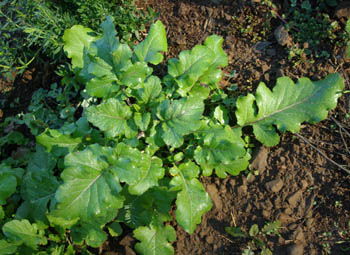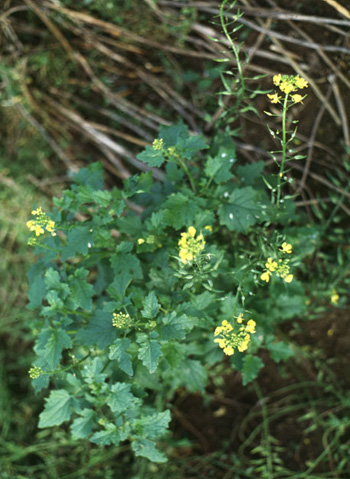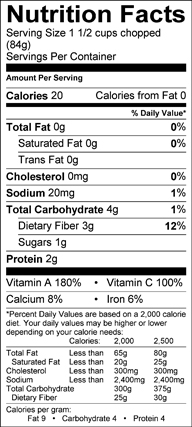Contents:
Common Names | Parts Usually Used | Plant(s) & Culture | Where Found | Medicinal Properties | Biochemical Information
Legends, Myths and Stories | Uses | Formulas or Dosages | Nutrient Content | Warning | Bibliography
Scientific Names

Black Mustard
- Brassica nigra L.
White Mustard
- Brassica hirta L.
- Sinapsis alba L.
- Cruciferae
- Crucifer family
Common Names
Black Mustard
- Mustard
White Mustard
- Ta-chieh (Chinese name)
- White mustard seed
- Yellow mustard kedlock
- Yellow mustard seed
Parts Usually Used
Brassica nigra L.
Seed
Sinapsis alba L.
Seed
Back to Top

Description of Plant(s) and Culture
Brassica nigra L.
Black mustard is an annual plant; the many, erect, branching, angular stem grows 2-7 feet tall and bears large, alternate leaves, the lower ones lyrately pinnatifid and somewhat bristly, the upper glabrous, entire, and lanceolate. Yellow flowers grow in elongating clusters in terminal racemes from June into November. Each has 4 petals. The black seeds develop in upright, bulgy, cylindrical, beaked pods which are held on stalks closely pressed to the stem.
Sinapsis alba L.
Very similar to black mustard.
Back to Top
Where Found
Brassica nigra L.
Widely cultivated and also found wild in many parts of the world, including the fields and waste places of North America, except the far northern parts.
Sinapsis alba L.
Widely cultivated and also found wild in many parts of the world, including the fields and waste places of North America, except the far northern parts.
Back to Top
Medicinal Properties
Brassica nigra L.
Appetizer, digestive, irritant
Sinapsis alba L.
Pungent, stimulant, condiment, emetic, laxative, irritant, digestive
Seeds are analgesic, carminative, stimulant, expectorant
Back to Top
Biochemical Information
Sinapsis alba L.
Sinalbin, sinapine, myrosin
Back to Top
Legends, Myths and Stories
Both black and white mustard have similar properties, although most herbalists say the black mustard is the stronger. Culpeper recommended an external use to treat joint pain and backache. To be taken internally with honey for coughs. Today, mustard is generally used externally.
Never use the undiluted oil.
In Nevada, several members of the mustard family develop orange colored seeds, which are carefully collected and ground to make gravy by the Native Americans. This gravy is made by adding hot water to the meal. One variety of wild mustard seldom sets on seeds. The Native American name given to this one means: “Old Maid Sister.”
There is a wild weed mustard, called “Acjha.” Grows on hillsides and is ripe in late June. The seeds are small and red.
Brassica nigra L.
Use of the seed is thought to have dated back to the time of the Greeks, who also used the plant’s green leaves as a potherb and salad.
Some references say Black Mustard belongs to the mustard family, but Webster’s dictionary and the majority of references claim the crucifer family. The reader knows best.
Black mustard seed is used for giving a biting sensation to cordials and wines.
Sinapsis alba L.
This is the common yellow (white) ground mustard that is used with food, even though some herbalists claim it is harmful used in this way.
The leaves of the white mustard are quite tasty in salads.
Back to Top
Uses
Brassica nigra L.
Black mustard is generally used externally as an irritant to encourage blood flow toward the surface in cases of rheumatism, sciatica, peritonitis, neuralgia, and various internal inflammations. Black mustard can be taken internally in very small amounts to promote appetite, and stimulate the flow of gastric juices. In poultices to treat colds, fever, bronchitis, ague, sciatica, crick in the neck, chilblains, relieve constipation, or to promote kidney action, toothache, headaches. In stronger doses it causes vomiting.
Mustard oil can be mixed with rectified alcohol (1 part oil to 40 parts alcohol) and used as a lotion externally for gouty pains, lumbago, and rheumatism.
Also used as a spice, a condiment, leaves in salads, cooked as a vegetable, season pickles, etc. Ground seeds used as a snuff for headaches.
Sinapsis alba L.
An old-fashioned remedy to produce vomiting. Used as a poultice for pneumonia, bronchitis, chest colds, and flu.
Mustard seeds are used to treat joint pain, watery, oozing, chronic sores, stops coughs, dispels phlegm, improves digestion.
Back to Top
Formulas or Dosages
Brassica nigra L.
Plaster: Mix mustard powder with cold water to make a thick paste, then spread the paste on a linen cloth. Put a layer of gauze over the affected area and then lay on the mustard cloth. The skin will begin to burn. Leave the mustard in place until the burning becomes too uncomfortable. Thoroughly clean any remaining mustard paste from the skin. Powder the skin with rice flour and wrap the area with dry cotton. The skin should be back to normal in a few days. Do not use on sensitive areas. For persons with sensitive skin, mix the mustard powder with rye flour to reduce its effect.
Sinapsis alba L.
Mustard plaster: mix 1 part mustard with 4 parts whole wheat flour. Make into a paste by mixing with warm water. Make it thick enough to spread on a cloth. If the mustard is very strong, it may blister the skin. When the burning becomes too uncomfortable, it should be removed. After it is removed, cleanse the skin thoroughly.
If you wish to leave the plaster on longer, it can be made weaker. Mix the mustard and flour with the whites of eggs instead of water and it will not blister the skin.
Back to Top
Nutrient Content

Warning
Brassica nigra L.
Allyl isothiocyanate (responsible for mustard flavor) is a strong irritant.
May blister skin, red, burnlike skin blotches, sometimes developing into ulcers.
Large amounts or prolonged use of black mustard, internally or externally, can cause serious irritation and inflammation; never let undiluted mustard oil contact the skin.
Black Mustard must be used in small quantities and for short periods.
Never use the undiluted oil.
Sinapsis alba L.
Mustard seeds should not be used if there is a fever condition.
Never use the undiluted oil.
Back to Top
Bibliography
![]() The Herb Book
The Herb Book, by John Lust, Bantam Books, 666 Fifth Avenue, New York, NY. copyright 1974.
![]() Eastern/Central Medicinal Plants
Eastern/Central Medicinal Plants, by Steven Foster and James A. Duke., Houghton Mifflin Company, 215 Park Avenue South, New York, NY 10000
![]() Back to Eden
Back to Eden, by Jethro Kloss; Back to Eden Publishing Co., Loma Linda, CA 92354, Original copyright 1939, revised edition 1994
![]() Chinese Medicinal Herbs
Chinese Medicinal Herbs, compiled by Shih-Chen Li, Georgetown Press, San Francisco, California, 1973.
![]() Culpeper’s Complete Herbal & English Physician: Updated With 117 Modern Herbs
Culpeper’s Complete Herbal & English Physician: Updated With 117 Modern Herbs, by Nicholas Culpeper, Meyerbooks, publisher, PO Box 427, Glenwood, Illinois 60425, 1990, (reprint of 1814)
![]() Indian Uses of Native Plants
Indian Uses of Native Plants, by Edith Van Allen Murphey, Meyerbooks, publisher, PO Box 427, Glenwood, Illinois 60425, copyright 1958, print 1990
![]() The Herbalist Almanac
The Herbalist Almanac, by Clarence Meyer, Meyerbooks, publisher, PO Box 427, Glenwood, Illinois 60425, copyright 1988, fifth printing, 1994
 Earl Mindell’s Herb Bible
Earl Mindell’s Herb Bible, by Earl Mindell, R.Ph., Ph.D., Simon & Schuster/Fireside, Rockefeller Center 1230 Avenue of the Americas, New York, New York 10020
![]() The Nature Doctor: A Manual of Traditional and Complementary Medicine
The Nature Doctor: A Manual of Traditional and Complementary Medicine, by Dr. H.C.A. Vogel; Keats Publishing, Inc., 27 Pine Street (Box 876) New Canaan, CT. 06840-0876. Copyright Verlag A. Vogel, Teufen (AR) Switzerland 1952, 1991
Herbal Gardening, compiled by The Robison York State Herb Garden, Cornell Plantations, Matthaei Botanical Gardens of the University of Michigan, University of California Botanical Garden, Berkeley., Pantheon Books, Knopf Publishing Group, New York, 1994, first edition
![]() Indian Herbalogy of North America
Indian Herbalogy of North America, by Alma R. Hutchens, Shambala Publications, Inc., Horticultural Hall, 300 Massachusetts Avenue, Boston, Massachusetts 02115, 1973
 Old Ways Rediscovered
Old Ways Rediscovered, by Clarence Meyer, Meyerbooks, publisher, PO Box 427, Glenwood, Illinois 60425, published from 1954, print 1988
![]() Planetary Herbology
Planetary Herbology, by Michael Tierra, C.A., N.D., O.M.D., Lotus Press, PO Box 325, Twin Lakes. WI 53181., Copyright 1988, published 1992
![]() Webster’s New World Dictionary
Webster’s New World Dictionary, Third College Edition, Victoria Neufeldt, Editor in Chief, New World Dictionaries: A Division of Simon & Schuster, Inc., 15 Columbus Circle, New York, NY 10023
![]() The Yoga of Herbs: An Ayurvedic Guide to Herbal Medicine
The Yoga of Herbs: An Ayurvedic Guide to Herbal Medicine, by Dr. David Frawley & Dr. Vasant Lad, Lotus Press, Twin Lakes, Wisconsin, Second edition, 1988.
 An Instant Guide to Medicinal Plants
An Instant Guide to Medicinal Plants, by Pamela Forey and Ruth Lindsay, Crescent Books (January 27, 1992).
 The Rodale Herb Book: How to Use, Grow, and Buy Nature’s Miracle Plants (An Organic gardening and farming book)
The Rodale Herb Book: How to Use, Grow, and Buy Nature’s Miracle Plants (An Organic gardening and farming book), edited by William H. Hylton, Rodale Press, Inc. Emmaus, PA, 18049., 1974
